![]()
![]()
![]()
Use LEFT and RIGHT arrow keys to navigate between flashcards;
Use UP and DOWN arrow keys to flip the card;
H to show hint;
A reads text to speech;
38 Cards in this Set
- Front
- Back
- 3rd side (hint)
|
Reproductive mode of eukaryotes by which offspring arise from a single parent only. |
Asexual Reproduction |
|
|
|
A series of events from the time a cell forms until it's cytoplasm devides. |
Cell Cycle |
|
|

Name and describe the steps of the cycle shown above. |

|
|
|
|
Chromosomes with the same length, shape, and genes. |
Homologous Chromosomes |
|
|
|
In a eukaryotic cell cycle, the interval between mitotic divisions when a cell grows, roughly doubles the number of its cytoplasmic components, and replicates it's DNA. a cell spends most of its life in this interval. |
Interphase |
|
|
|
Nuclear division mechanism that maintains the chromosome number. |
Mitosis |
The basis of increases in body size, tissue remodeling during development as well as ongoing replacements of damaged or dead cells. |
|
|
In the cell cycle. The interval of growth before DNA replication. The cells chromosomes are unduplicated. |
G1 (gap1) |
|
|
|
Interval of time in the cell cycle in which the cell copies it's DNA. the time of synthesis. |
S phase |
|
|
|
The interval of the cell cycle after DNA replication and before mitosis. The cell prepares to divide during this stage. |
G2 (gap 2) |
|
|
|
The final interval in the cell cycle in which the nucleus and cytoplasm divide and each descendant cell (daughter cells) begins the cycle anew in interphase. |
Mitosis |
|
|
|
These components are built within the cell cycle in order to stop the cycle from proceeding until certain conditions are met. |
Checkpoints |
|
|
|
Stage of mitosis during which sister chromatids separate and move towards opposite spindle poles. each sister chromatid has now become an individual, unduplicated chromosome. |
Anaphase |
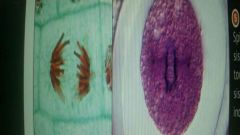
|
|
|
Stage of mitosis at which all chromosomes are aligned midway between spindle poles. |
Metaphase |

|
|
|
Stage of mitosis during which chromosomes become visible as they condense. One of the two centrosomes moves to the opposite of the cell as the nuclear envelope breaks up completely. Spindle microtubules assemble and bind to chromosomes at the centromere. Sister chromatids become attached to opposite centrosomes. |
Prophase |
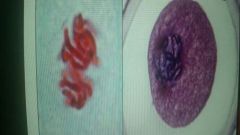
|
|
|
Temporary structure that moves chromosomes during nuclear division; consists of microtubules. |
Spindle |
|
|
|
Stage of mitosis during which chromosomes arrive at opposite spindle poles and decondense (loosen up). Mitosis ends when a new nuclear envelope forms around each cluster of chromosomes. |
Telophase |
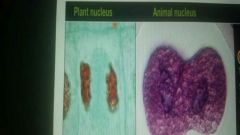
|
|
|
A disk-shaped structure that forms during cytokinesis in a plant cell; matures as a cross wall between the two new nuclei. |
Cell Plate |
|
|
|
In a dividing animal cell, the indentation where cytoplasmic division will occur. |
Cleavage Furrow |
|
|
|
Cytoplasmic division |
Cytokinesis |
|
|
|
A band of actin and myosin filaments that wraps around an animal cell's midsection during cytokinesis. |
Contractile Ring |
|
|
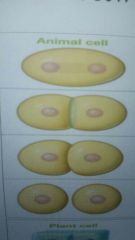
Name and describe cytoplasmic division of animal cells. |
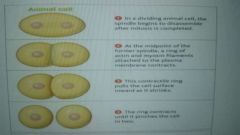
|
|
|
|
Noncoding, repetitive DNA sequence at the end of chromosomes; protects the coding sequences from degradation. |
Telomeres |
Provide a buffer against the loss of more valuable internal DNA. |
|
|
"Immortal cells" found in few numbers in adult cells that retain the ability to divide indefinitely, replacing cell lineages that die out. |
Stem Cells |
|
|
|
Enzymes that are continuously produced by stem cells. They reverse the telomere shortening that normally occurs after DNA replication. |
Telomerase |
|
|
|
The amount of nucleotides typically shortened off a eukaryotic chromosome with each DNA replication. |
100 |
|
|
|
Disease that occurs when a malignant neoplasm physically and metabolically disrupts body tissues. |
Cancer |
|
|
|
Molecule that stimulates mitosis and differentiate. |
Growth Factor |
|
|
|
The process in which malignant cells spread from one part of the body to another. |
Metastasis |
|
|
|
An accumulation of abnormally dividing cells. |
Neoplasm |
|
|
|
Gene that helps transform a normal cell into a tumor cell. A gene with tumor causing mutation. |
Oncogene |
|
|
|
Gene that, by mutation, can become an oncogene. Gene encoding proteins that promote mitosis. |
Proto-oncogene |
|
|
|
A neoplasm that forms a lump |
Tumor |
|
|
|
Gene products that inhibit motosis |
Tumor Suppressors |
|
|
|
The process in which cells form a single layer then stop dividing. If some are damaged or scraped away, the remaining cells divide to replace the cells lost and stop once a new single layer is formed. |
Density dependent inhibition |
|
|
|
A characteristic of transformed cells, such as malignant cells, do not require a growing surface and form high density colonies. |
No density dependent inhibition |
|
|
|
A characteristic of Cells that require a growing surface. |
Anchorage Dependence |
|
|
|
The cells of Henrietta Lacks in which were used in medical research. Through them were discovered that cancer cells were immortal (provided nutrients). They have been multiplying in culture ever since 1951. |
HeLa Cells |
|
|
|
Describe the difference between benign and malignant cells. |
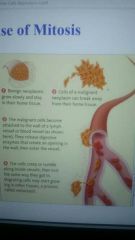
|
|

